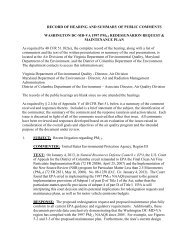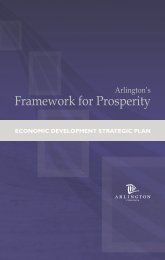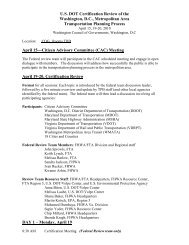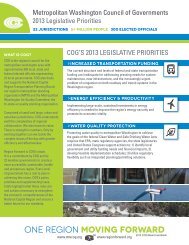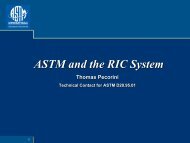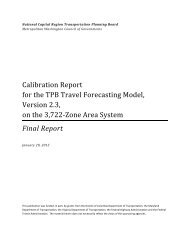PTI Local Government Energy Assurance Guidelines - Metropolitan ...
PTI Local Government Energy Assurance Guidelines - Metropolitan ...
PTI Local Government Energy Assurance Guidelines - Metropolitan ...
Create successful ePaper yourself
Turn your PDF publications into a flip-book with our unique Google optimized e-Paper software.
Wind <strong>Energy</strong> Options<br />
Developing and capitalizing on domestic energy sources with known and stable costs can significantly improve<br />
local energy reliability. Wind power is one of the most abundant fuel supplies available, and one of the most cost<br />
competitive renewable energy resources. Total wind power capacity now operating in the U.S. is over 35,000<br />
megawatts (MW), generating enough to power the equivalent of 9.7 million homes. 9<br />
Wind energy is big business. About 10 years ago, the wind industry began to experience major growth in the<br />
United States, thanks in a large part to State and Federal tax incentives, State-level renewable energy requirements<br />
and—beginning around 2001—rising fossil fuel prices. Wind is now the fastest growing source of electricity in the<br />
world. In 2008, more than 27,000 megawatts (MW) of new wind capacity were installed worldwide, representing a<br />
total investment of more than $51 billion, and 8,500 MW of this was in the U.S.—a 36 percent increase over 2007.<br />
Nearly 10,000 MW of new wind capacity was added in the U.S. in 2009, despite a recession. More wind power was<br />
installed in the U.S. in 2007-2008 than in the previous 20 years combined—a $27 billion investment. 10<br />
How can wind energy help energy assurance efforts? Wind energy can assist local governments in diversifying<br />
their fuel supply and increasing their resilience. Electric system operators utilize wind energy to reduce the output<br />
required from fossil-fueled power plants. In addition, wind energy can assist through:<br />
■ ■ Diversification: It diversifies the electricity portfolio and represents an indigenous energy source with stable<br />
prices not subject to fuel volatility.<br />
■ ■ Water savings: The United States Geological Survey (USGS) estimates that electricity generation is<br />
responsible for 50 percent of all water withdrawals in the U.S., followed by irrigation at 30 percent. Wind<br />
energy does not require water cooling, so it saves significant quantities of water.<br />
■ ■ Environmental improvement: In addition to water savings, wind energy helps avoid air pollution and<br />
emissions from conventional power sources.<br />
■ ■ Economic benefits: Wind energy reduces demand for traditional fossil fuels, which in turn reduces fuel prices<br />
and helps to stabilize electricity rates. Plus, it creates a new income source for landowners and tax revenues<br />
for the local government.<br />
Opponents of wind projects usually point to avian (bird) mortality, aesthetic concerns, and noise pollution related<br />
to turbines. These issues are relevant and worth reviewing, and are usually easy to address through the permitting<br />
process. Conditions under which a project will operate can be spelled out. For example, a project permit might limit<br />
the sound level or require a setback distance from roads, houses, or property lines.<br />
As part of a local energy assurance effort, planners can create a separate ordinance to permit wind energy facilities.<br />
In Pike County, Illinois, the County Board created a permitted use ordinance that lays out standard conditions for<br />
wind projects. Decision-makers in Klickitat County, Washington, designated specific areas to encourage and guide<br />
wind energy development. The local authorities in Kern County, California, conducted a countywide environmental<br />
impact review to enable development of the Tehachapi Wind Resource Area.<br />
9<br />
David Von Walland, “Wind Power, A Gust of Alternative <strong>Energy</strong>,” January 31, 2011, (http://ezinearticles.com/?Wind-Power,-A-Gust-Of-<br />
Alternative-<strong>Energy</strong>&id=5828920).<br />
10<br />
The American Wind <strong>Energy</strong> Association, November 2010.<br />
<strong>Local</strong> <strong>Government</strong> <strong>Energy</strong> <strong>Assurance</strong> <strong>Guidelines</strong> – Version 2.0 | 19



